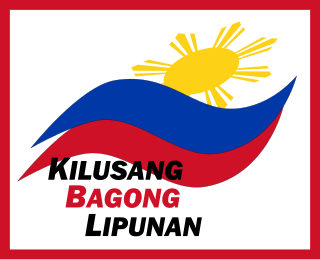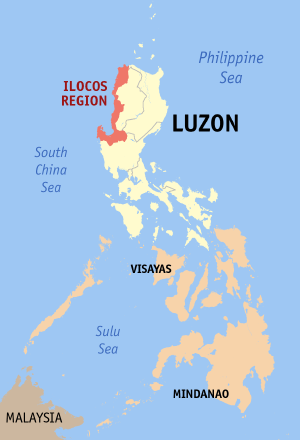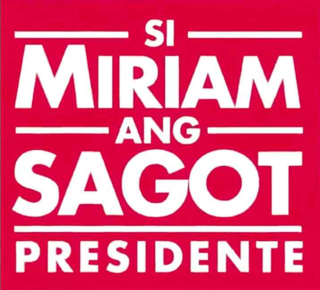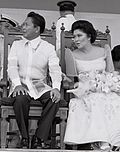
Ferdinand "Bongbong" Romualdez Marcos Jr., commonly referred to by the initials PBBM or BBM, is a Filipino politician who is the 17th and current president of the Philippines. He previously served as a senator from 2010 to 2016. He is the second child and only son of tenth president, kleptocrat and dictator Ferdinand Marcos and former first lady Imelda Marcos.

Maria Imelda Josefa Remedios "Imee" Romualdez Marcos is a Filipina politician and former actress serving as a Senator since 2019. She is the daughter of Ferdinand Marcos and former first lady Imelda Marcos and the older sister of the current president, Bongbong Marcos. She previously served as governor of Ilocos Norte from 2010 to 2019 and as representative of Ilocos Norte's 2nd district from 1998 to 2007.

The New Society Movement, formerly named the New Society Movement of United Nationalists, Liberals, et cetera, is a right-wing political party in the Philippines. It was first formed in 1978 as an umbrella coalition of parties supporting then-President Ferdinand E. Marcos for the Interim Batasang Pambansa and was his political vehicle during his 20-year regime. It was reorganized as a political party in 1986, and is the furthest to the right of the political spectrum among active parties after Marcos' ouster.

This article covers the history of the current Philippine republican state following the 1986 People Power Revolution, known as the Fifth Philippine Republic.
This list of presidential elections in the Philippines includes election results of both presidential and vice presidential elections since 1899 with the candidates' political party and their corresponding percentage.

The Nacionalista Party is the oldest political party in both the Philippines and in Southeast Asia in general. It is responsible for leading the country throughout most of the 20th century since its founding in 1907; it was the ruling party from 1935 to 1946, 1953–1961 and 1965–1978.

Elections were held in the Ilocos Region for seats in the House of Representatives of the Philippines on May 10, 2010.
Political families, labeled as "political dynasties" in the Philippines, usually have a strong, consolidated support base concentrated around the province in which they are dominant. Members of such dynasties usually do not limit their involvement to political activities, and may participate in business or cultural activities.

The 2016 Philippine presidential and vice presidential elections were held on Monday, May 9, 2016, as part of the 2016 general election. This was the 16th direct presidential election in the Philippines since 1935 and the fifth sextennial presidential election since 1992.

The 2016 election of members to the Senate of the Philippines was the 32nd election of members to the Senate of the Philippines. It was held on Monday, May 9, 2016, The seats of 12 senators elected in 2010 were filled during this election. The winners in this election joined the winners of the 2013 election to form the 17th Congress of the Philippines. The senators elected in 2013 served until June 30, 2019, while the senators elected in this election would serve up to June 30, 2022.
This is a list of candidates in the 2016 Philippine presidential and vice presidential elections.

The 2016 presidential campaign of Miriam Defensor Santiago, a then-incumbent Senator of the Philippines, was announced on October 13, 2015 at a book signing event. Miriam Defensor-Santiago submitted her certificate of candidacy (COC) on October 16, 2015. She was fifth overall in the election and lost to Rodrigo Duterte. Santiago died of lung cancer five months later.

The 2019 election of members to the Senate of the Philippines was the 33rd election of members to the Senate of the Philippines for a six-year term. It was held on May 13, 2019.
The following is the official canvassing of votes by the Congress of the Philippines for the 2016 Philippine presidential and vice presidential election. The canvassing started on May 25, 2016 and ended 2 days later. This was the fastest congressional canvassing process in Philippine electoral history until 2022.

The burial of Ferdinand Marcos, a former Philippine President who ruled as a dictator for 21 years, took place on November 18, 2016, at the Libingan ng mga Bayani in Fort Andres Bonifacio, Taguig, Metro Manila, Philippines. Marcos had been elected the 10th President of the Philippines in 1965, but declared Martial Law in 1972 before his final constitutionally allowed term was over, holding on to power until his overthrow by the People Power Revolution in 1986.
The term "Marcos mansions" refers to at least 50 upscale residences in the Philippines of the family of President Ferdinand Marcos. These are aside from the various overseas landholdings of the Marcos family, which are spread around the world. The Supreme Court of the Philippines considers these landholdings as part of the "ill-gotten wealth" of the Marcos family, based on the definitions set forth in Republic Act No. 1379, which had been passed in 1955.

The Marcos family is a political family in the Philippines. They have established themselves in the country's politics, having established a political dynasty that traces its beginnings to the 1925 election of Mariano Marcos to the Philippine House of Representatives as congressman for the second district of Ilocos Norte; reached its peak during the 21-year rule of Ferdinand Marcos as president of the Philippines that included his 14-year dictatorship beginning with the declaration of Martial Law throughout the country; and continues today with the political careers of Imelda Marcos, Imee Marcos, Sandro Marcos and reached a fresh political apex with the presidency of Bongbong Marcos.
These are the people who, at one time or another, had been considered, announced, declined or withdrew his or her candidacy in the 2019 Philippine Senate election.























